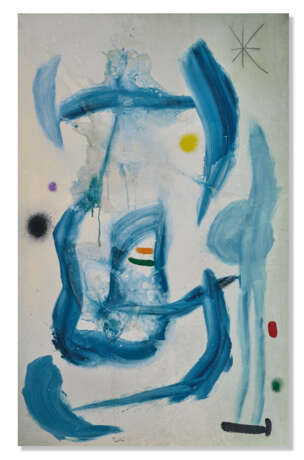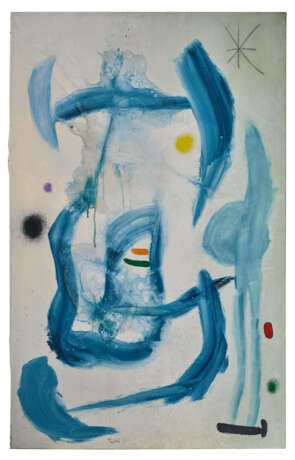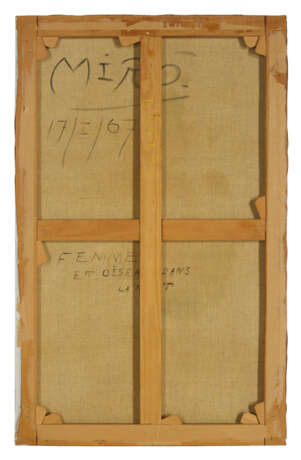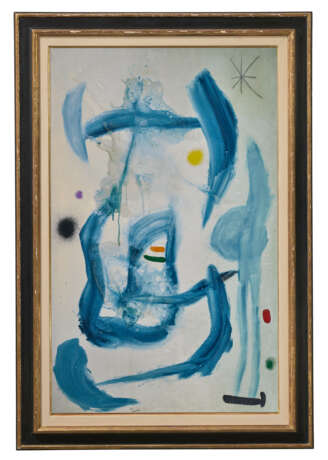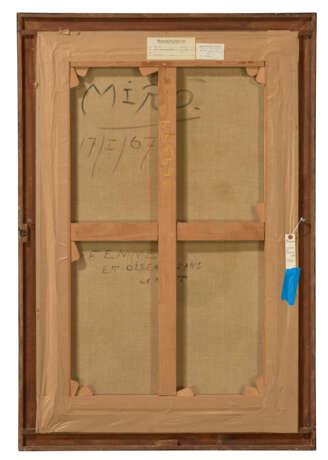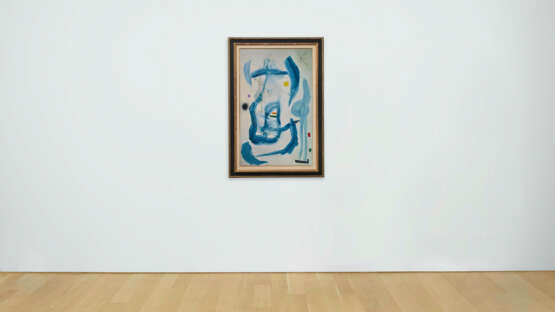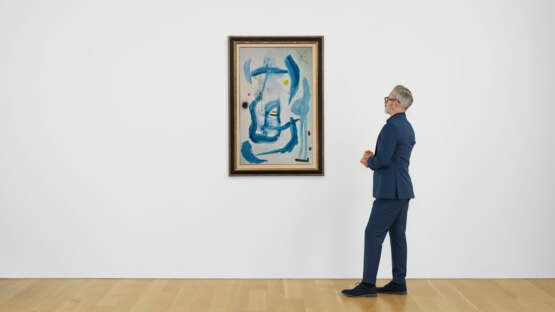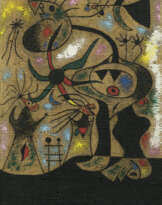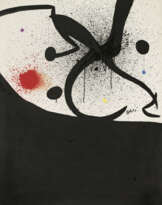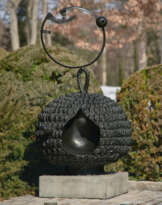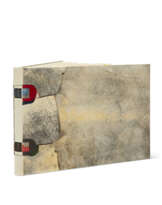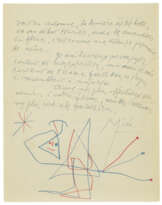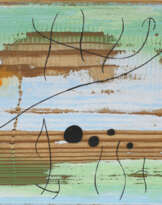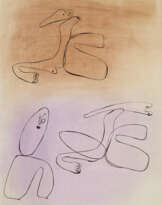ID 1053096
Lot 320 | Joan Miró (1893-1983)
Estimate value
€ 1 500 000 – 2 500 000
Femmes et oiseaux dans la nuit
signé 'Miró' (en bas à gauche); signé, daté et inscrit 'MIRÓ. 17/I/67 FEMMES ET OISEAUX DANS LA NUIT' (au revers)
huile sur toile
117 x 73.4 cm.
Peint le 17 janvier 1967
signed 'Miró' (lower left); signed, dated and inscribed 'MIRÓ. 17/I/67 FEMMES ET OISEAUX DANS LA NUIT' (on the reverse)
oil on canvas
46 x 28 7⁄8 in.
Painted on 17 January 1967
Provenance
Galerie Maeght, Paris.
Marisa del Re Gallery, New York.
Rosenberg Fine Arts, Ltd., Toronto.
Acquis auprès de celle-ci par la famille du propriétaire actuel en janvier 1983.
Literature
P. Gimferrer, Miró, Catalàn universel, Barcelone, 1978, p. 95, no. 91 (illustré en couleurs).
J. Dupin et A. Lelong-Mainaud, Joan Miró, Catalogue raisonné, Paintings, 1959-1968, Paris, 2002, vol. IV, p. 198, no. 1256 (illustré en couleurs, p. 199).
Exhibited
Saint-Paul-de-Vence, Fondation Maeght, Joan Miró, Peintures, Sculptures, Dessins, Céramiques, 1956-1979, juillet-septembre 1979, p. 169, no. 14.
Further details
Hommage à Eph et Shirley Diamond
Eph Diamond était le self-made man par excellence. Issu d'une famille de travailleurs immigrés, il voit sa vie basculer le jour où son père emprunte cent dollars sur sa propre assurance-vie pour couvrir les frais d'inscription de son fils à la Queen's University, l'un des établissements d'enseignement supérieur les plus prestigieux du Canada. Eph le lui revaudra bien : il travaille dur pour payer ses études, et finit par décrocher un diplôme en génie électrique avec mention. Le destin voudra qu'il devienne l'un des promoteurs immobiliers nord-américains les plus influents du XXe siècle. D'abord président de la Cadillac Development Corporation, puis de la Cadillac Fairview Corporation, Eph a contribué à façonner le paysage urbain de tout un continent. C'est avec ce même esprit ouvert et visionnaire qu'il a nourri sa passion pour l'art et assemblé, avec le concours de son épouse Shirley, une collection exceptionnelle : un ensemble d'œuvres nées de mouvements d'avant-garde qui – comme Eph redessinant la ville moderne – ont transformé le paysage culturel contemporain.
Engagé dans la marine canadienne durant la Seconde Guerre mondiale, Eph rencontre Shirley dans un caserne du Nord de l'Ontario, avant de braver son mal de mer pour lui rendre visite à Saint Catharines, près des chutes du Niagara. De cette aventure amoureuse naît un mariage et une petite famille, qu'Eph et Shirley se démènent pour maintenir après la guerre. Eph apprend les ficelles des métiers du bâtiment en menant de front divers chantiers pour son employeur. Entrepreneur dans l'âme, il rêve de travailler à son compte : c'est chose faite en 1953, lorsqu'il fonde avec deux amis la Cadillac Development Corporation. Sa propre histoire familiale aiguille sa manière d'envisager la profession. Selon Eph, « Le promoteur est là pour représenter ceux qui ne sont pas encore propriétaires mais qui voudraient le devenir. Nous en sommes les porte-parole ». Dans un souci d'excellence, la société Cadillac s'engagera à construire des logements abordables de grande qualité, afin de faciliter l'accès à la propriété des foyers les plus modestes et favoriser l'intégration d'immigrés comme ses parents et ceux de Shirley, arrivés au Canada au tournant du siècle. Cadillac devient bientôt le plus important des constructeurs d'habitations de Toronto, lesquels forment, conjointement, l'un des plus grands parcs immobiliers résidentiels d'Amérique du Nord. Après la fusion de Cadillac et Fairview, Eph orchestre par ailleurs de nombreux projets majeurs dans le bâtiment commercial marqués par une esthétique résolument moderne : en découlent certains des gratte-ciels les plus célèbres de Toronto, véritables joyaux d'audace architecturale. Eph se retire de son poste de directeur de Cadillac Fairview en 1979 pour se consacrer pleinement à Shirley, sa compagne et confidente de toujours, leurs quatre fils et leurs petits-enfants toujours plus nombreux. Réputé pour son inébranlable intégrité dans les affaires, il demeurera l'un des conseillers privilégiés de Cadillac durant les décennies à suivre. Son aplomb et son intelligence stratégique demeurent aujourd'hui encore au fondement-même de la philosophie et du succès durable de l'entreprise dont il fut le fondateur. Honoré de nombreuses distinctions au cours de sa carrière, il entre notamment au Panthéon des personnalités canadiennes des Affaires en 1988, et reçoit en 1994 l'Ordre du Canada.
Eph et Shirley acquièrent durant les années 1970 les premières œuvres d'une collection qui reflète les mutations radicales de l'art d'après-guerre. De l'avant-gardisme européen d'un Fernand Léger ou d'un Joan Miró, au modernisme singulièrement britannique de Barbara Hepworth, Ben Nicholson ou Henry Moore, jusqu'à l'abstraction américaine révolutionnaire de Kenneth Noland, leur patrimoine synthétise parfaitement les mouvements tectoniques qui ont secoué le monde artistique de part et d'autre de l'Atlantique au cours des cinquante dernières années. Armés d'un flair hors pair et d'une grande sensibilité esthétique, Eph et Shirley ont réuni au gré de leurs envies et de leur intuition des œuvres de styles variés, tous supports confondus, optant souvent pour des artistes devenus très prisés par la suite. Il en résulte une collection d'une modernité et d'un avant-gardisme extraordinaires, qui résonne avec les immeubles iconiques de Cadillac Fairview.
Eph et Shirley accordaient une importance toute particulière à la tradition juive dont ils étaient les héritiers et dont ils ont véhiculé les valeurs au fil d'une vie entière de philanthropie. De nombreuses organisations communautaires, sociales et culturelles ont bénéficié des dons généreux du couple Diamond, parmi lesquelles United Way (Alliance pour l'éducation), l'hôpital Sunnybrook de Toronto, le Musée royal de l'Ontario ou la Compagnie nationale d'opéra du Canada, ainsi que des associations juives d'aide humanitaire, telles que Save A Child's Heart, Ve'ahavta et la Fondation Baycrest. Ils ont également largement contribué au financement d'initiatives israéliennes telles que l'Université hébraïque de Jérusalem et United Jewish Appeal. En 1979, Eph a reçu la médaille du mérite de l'État d'Israël pour ses services humanitaires ; l'Université hébraïque lui a également décerné un doctorat à titre honorifique.
Eph s'est éteint en 2008 à l'âge de 87 ans ; Shirley est décédée plus récemment, en 2022, à 97 ans. La collection offerte à la vente provient de leur résidence principale à Toronto, un penthouse situé au sommet de l'un des gratte-ciels les plus anciens et les plus emblématiques de la ville.
Eph and Shirley Diamond: A Tribute
Eph Diamond was the quintessential self-made man. He grew up in a working class immigrant family and his father borrowed $100 against his own life insurance policy so that Eph could enroll at Queen’s University, one of Canada’s most prestigious institutes of higher education. His son repaid this trust, studying electrical engineering and graduating with honors, all the while working to pay his own tuition. He would go on to become one of the most successful North American real estate developers of the 20th century, and as CEO of Cadillac Development Corporation, later the Cadillac Fairview Corporation, Eph shaped the urban landscape of cities all over the continent. This broad and forward looking vision was also reflected in his interest in art, and together with his wife Shirley, the couple collected works by artists who transformed the cultural landscape as he had transformed the urban landscape.
While serving in the Canadian navy during World War II, Eph met Shirley at a lodge in northern Ontario and later, he braved his stubborn sea sickness to take the ferry to visit her in St. Catherines. They fell in love, married, and worked hard to make a living for their young family after the War. Eph mastered the intricacies of the construction industry as he managed various projects for his employer. But working for someone else restricted his entrepreneurial drive, so he co-founded the Cadillac Development Corporation with two friends in 1953. Eph’s own family history shaped how he understood his work. “The developer represents those who don’t have a home but want one. We’re their voice,” he said. Always committed to excellence, Cadillac built high-quality, affordable homes that smoothed the way for immigrants similar to his and Shirley’s own parents who had arrived in Canada in the late 19th and early 20th centuries. Indeed, Cadillac was the largest of the residential high-rise developers in Toronto, which collectively produced one of the most significant apartment stocks in North America. In addition, and after the merger of Cadillac and Fairview produced Cadillac Fairview, Eph led a number of significant commercial projects where he embraced a modern aesthetic, and Cadillac Fairview’s commercial buildings have long become gems on the Toronto skyline. He retired as CEO of Cadillac Fairview in 1979 to spend more time with Shirley, his constant companion and confidante, and their four sons and growing group of grandchildren. He continued to advise Cadillac for decades and his bold strategic thinking provided the historical underpinning of Cadillac Fairview’s long-term success, while his unwavering commitment to integrity in business earned him a sterling reputation. Among many awards received during his successful lifetime in business, he was inducted into the Canadian Business Hall of Fame in 1988 and received the Order of Canada in 1994.
In the 1970s, Shirley and Eph began a collection that reflected the dramatic shifts taking place in the postwar art historical canon. From the European avant-garde art of Fernand Léger and Joan Miró, the uniquely British Modernism of Barbara Hepworth, Ben Nicholson and Henry Moore, to the groundbreaking American abstraction of Kenneth Noland, their collection is a capsule of the tectonic artistic shifts that took place on both sides of the Atlantic over the past fifty years. With their highly attuned sense of style and taste, Eph and Shirley acquired what they loved across genres and media, intuitively choosing many artists who later became highly sought-after. Together, they assembled a collection of modern, cutting-edge works in step with the iconic buildings Cadillac Fairview built.
Eph and Shirley valued their Jewish heritage and exemplified the values of their faith throughout decades of philanthropy. The Diamonds gave generously to community organizations like United Way, Sunnybrook Hospital, and to several arts organizations including the Royal Ontario Museum and the Canadian Opera Company, as well as to Jewish organizations which serve the broader population such as Save A Child’s Heart, Ve’ahavta, and the Baycrest Foundation. They have also given generously to Jewish community organizations such as the Hebrew University and United Jewish Appeal. In 1979, the State of Israel awarded Eph with the Prime Minister’s Medal for Humanitarian Services and he was awarded an Honorary Doctorate at the Hebrew University.
Eph passed away at the age of 87 in 2008 and Shirley recently passed in 2022 at the age of 97. The current collection being offered is from their Canadian penthouse residence atop of one of Toronto’s premier and original condominiums.
« Je peins ce que je suis, peut-être même ce que j'étais dans une autre vie. »
Joan Miró
Conservée dans la même collection particulière depuis plus de quarante ans, Femmes et oiseaux dans la nuit de Joan Miró est l'image même de l'allégresse. Sur un fond blanc, des touches azures enlevées traduisent les silhouettes des femmes et des oiseaux éponymes, tandis que quelques éclats de couleurs vives suggèrent la voûte céleste. La réunion de ces éléments évoque les tableaux oniriques des années 1925-1927, qui restent parmi les plus énigmatiques de l'œuvre de Miró. Renonçant à tous les systèmes de perspective linéaire employés par les artistes depuis la Renaissance, ladite série des années 1920 et la présente Femmes et oiseaux dans la nuit sont composés d'un assemblage similaire de motifs rudimentaires et de formes calligraphiques, disposés au sein d'un espace éthéré, indéfini. « Je [m'évadais] dans l'absolu de la nature, se souvient Miró. Je voulais que mes formes semblent ouvertes à l'appel magnétique du vide, qu'elles s'y laissent aller. J’étais très intéressé par le vide, cette vacance parfaite. Je le mettais dans mes fonds délavés et brouillés, et les graphismes qui les parcouraient étaient les signes de ma démarche onirique » (J. Miró in D. Chevalier, ‘Miró’, 1962, réédité in M. Rowell, éd., Joan Miró, Selected Writings and Interviews, Londres, 1987, p. 264).
Femmes et oiseaux dans la nuit voit le jour en 1967, à une période où Miró se rend fréquemment aux États-Unis. Il traverse l'Atlantique pour la première fois en 1947, six ans après sa rétrospective au Museum of Modern de New York. Dans la monographie parue à cette occasion, le conservateur de l'exposition James Johnson Sweeney affirme que « Joan Miró est peintre avant tout. Voilà ce qui le distingue de la plupart de ses contemporains les plus reconnus. Voilà la clé de son évolution stylistique personnelle. C'est là la base sur laquelle il a bâti son approche de la forme purement picturale : la contribution la plus révolutionnaire qu'ait effectué n'importe quel peintre de la génération immédiatement postérieure à celle de Pablo Picasso » (J. Sweeny, Joan Miró, cat. exp., The Museum of Modern Art, New York, 1941, p. 13). À son arrivée à New York en 1947, Miró découvrait avec enthousiasme l'impact que sa rétrospective avait eu sur une cohorte d'artistes américains émergents ; vingt ans plus tard, il reste, outre-Atlantique, une influence de premier plan.
Les années 1950 et 1960 voient les échanges artistiques transatlantiques se multiplier et gagner en réciprocité. Miró découvre dans la peinture fougueuse et gestuelle des expressionnistes abstraits un langage libérateur, propice à un mode de représentation plastique plus intuitif, plus subjectif. Pour le Catalan, ces peintres américains de la période d'après-guerre ouvrent un nouveau champ de possibles. « En voyant ces tableaux, se rappelle-t-il, je me suis dit, "Toi aussi, tu en es capable : allez, lance-toi, tu vois, c'est bon !” » (J. Miró in M. Rowell, ‘Interview with Margit Rowell’, 1970, retranscrit in op. cit., 1987, p. 279). Prolifique, la production de Miró au cours des années 1960 témoigne de l'impact profond de ces vases communicants entre l'Europe et les États-Unis. Dans son vaste atelier de Palma de Majorque, il ose une expression de plus en plus audacieuse, et des œuvres aux dimensions toujours plus imposantes. Le répertoire de formes de Femmes et oiseaux dans la nuit, allié à son format de plus d'un mètre de haut, en sont bien la preuve. Si les arabesques et les touches de peinture en cascade évoquent à bien des égards les toiles de Joan Mitchell ou de Hans Hoffman, ses bleus aquatiques et ses jaunes vifs ne sont pas sans rappeler les étendues de flaques et de taches d'Helen Frankenthaler : trois des principaux représentants de l'École de New York.
S'il s'intéresse à ces expressions qui redessinent alors le paysage artistique américain, Miró lorgne aussi vers l'art et la poésie japonais. Il découvre le Japon pour la première fois en 1966, peu de temps avant de peindre Femmes et oiseaux dans la nuit ; il visite notamment Tokyo et Kyoto, où se tient alors une rétrospective en son honneur. Miró y côtoie céramistes, peintres, poètes et s'imprègne de toute une culture qu'il a toujours tenue en admiration. « J'étais fasciné par le savoir-faire des calligraphes japonais, et ils ont certainement eu un impact sur ma propre démarche artistique, admet-t-il. Je travaille de plus en plus dans des états de transe, je dirais même que ces temps-ci, je suis presque constamment en transe. Et je trouve ma peinture de plus en plus gestuelle » (ibid.).
Au fil des années 1960, les motifs de Miró se font plus expansifs, son trait plus fluide et enlevé. Son art devient, aussi, le théâtre d'un positionnement politique plus affirmé : Miró soutient ouvertement l'opposition grandissante au franquisme et renoue avec l'engagement qui avait sous-tendu, autrefois, ses toiles surréalistes. Or si ses opinions politiques trouvent avant tout leur terrain d'expression sur la toile, jamais elles ne compromettent la nature profondément poétique de son art. Quelque soit le contexte, ses étoiles, ses femmes, ses oiseaux continuent d'habiter allègrement son répertoire visuel, comme en témoigne ce tableau. Selon Jacques Dupin, ami de Miró et auteur de son catalogue raisonné, « la confrontation entre les éléments de terre et d'air, et le dialogue entre la femme et l'oiseau, traduisent la précarité de l'équilibre créé entre eux. […] Cette union suspendue […] se concrétise dans l'espace privilégié de la nuit charnelle, dans l'intimité de la nature, dont Miró ne se détourne jamais. La réalité se révèle comme une sorte d'interruption dans le doux écoulement du temps » (J. Dupin, Miró: Life and Work, Londres, 1962, p. 485).
La conjugaison de la poésie plastique très intime de Miró avec ce regain d'engagement politique et ces influences artistiques inédites apporte un souffle nouveau à l'œuvre de sa maturité. Dans des toiles telles que Femmes et oiseaux dans la nuit, l'artiste aborde avec une verve renouvelée des thèmes qui lui sont chers. Dupin dira d'ailleurs des tableaux de ces années-là : « Miró revenait toujours à lui-même, comme porté par les feux de San Joan. Agité par son grand âge, il défiait la mort avec la fibre blanche de chaque nouvelle toile, avec la moindre feuille de papier. Les tableaux des années 1960 restent insaisissables pour la simple raison que leur pluralité découle d'une nouvelle liberté [que] Miró avait acquise tel un indispensable talisman » (J. Dupin, Miró, New York, 1993, p., 372 et 329).
"I paint what I am, perhaps what I was in another life"
Joan Miró
Held in the same private collection for more than forty years, Joan Miró’s Femmes et oiseaux dans la nuit is a joy incarnate. Against a white ground, crystalline blue contours form the titular women and birds while splashes and daubs of bright colour conjure a celestial plane. Taken together, such elements invoke the artist’s dream paintings, which he had created between 1925 and 1927; these were among the most mysterious of his oeuvre. Forgoing the linear perspectival systems that artists had employed since the Renaissance, in both these paintings and the present work, Miró instead assembled rudimentary motifs and calligraphic forms within an undefined, airy space. ‘I escaped into the absolute of nature,’ he later reflected. ‘I wanted my spots to seem open to the magnetic appeal of the void, to make themselves available to it. I was very interested in the void, in perfect emptiness. I put it into my pale and scumbled grounds, and my linear gestures on top were the signs of my dream progression’ (J. Miró quoted D. Chevalier, ‘Miró’, 1962, reprinted in M. Rowell (ed.), Joan Miró: Selected Writings and Interviews, London., 1987, p. 264).
Femmes et oiseaux dans la nuit was painted in 1967 during a period in which Miró was travelling frequently to the United States. His first trip there was undertaken in 1947, six years after his retrospective opened at the Museum of Modern Art, New York. In the show’s accompanying monograph, the exhibition’s curator James Johnson Sweeney wrote, ‘Joan Miró is above all else a painter. This is what distinguishes him from so many of his best known contemporaries. This is the key to his own stylistic evolution. This is the basis on which he has built the most revolutionary contribution made within the strictly pictorial form by any painter of the generation immediately following that of Pablo Picasso’ (J. Sweeny, Joan Miró, exh. cat., The Museum of Modern Art, New York, 1941, p. 13). Upon his subsequent arrival, Miró was thrilled to learn the impact his art had on a rising generation of American avantgarde artists following this inaugural presentation; two decades later, he remained a prominent influence.
Over the ensuing years, the exchange of ideas across the Atlantic expanded and became noticeably more reciprocal. In the brash, gestural paintings of the Abstract Expressionists, Miró found a liberatory language for a more subjective mode of visual representation. To Miró, the artists of the post-war period revealed new pictorial possibilities: as he explained, ‘When I saw these paintings, I said to myself, you can do it, too: go to it, you see, it is OK!’ (J. Miró quoted in M. Rowell, ‘Interview with Margit Rowell’, 1970, reprinted in op. cit., 1987, p. 279). The 1960s accordingly were prolific years for Miró and his output reveals the profound impact of these encounters. In his vast new studio in Palma de Mallorca, he began to paint and sculpt on an increasingly larger scale and his work became bigger, more daring. In Femmes et oiseaux dans la nuit this is évident in both the size of the canvas itself, which measures over a metre tall, as well as its imagery. While the cascading brushwork and arabesques recall paintings by Joan Mitchell and Hans Hoffman, the aqueous blues and saturated yellow are reminders of Helen Frankenthaler’s potent soak-stain compositions; all three were central figures in the New York School.
In addition to the avant-garde idiom emerging in the United States, Miró also looked to Japanese art and poetry during this period. He had made his first trip to Japan in 1966, just prior to painting Femmes et oiseaux dans la nuit, visiting Tokyo and Kyoto where his retrospective was being exhibited. There he met with potters, painters, and poets, learning about and witnessing the culture which he had long admired. ‘I was fascinated by the work of the Japanese calligraphers and it definitely influenced my own working methods,’ he later said. ‘I work more and more in a state of trance, I would say almost always in a trance these days. And I consider my painting more and more gestural’ (ibid.).
As the decade progressed, Miró’s forms grew more open, his lines more dramatic and fluid. He also used his art as a site for political engagement. Public opposition to Francisco Franco’s dictatorship was growing and Miró supported these efforts. He reaffirmed some of the political frameworks that had underpinned his Surrealist canvases for Miró’s politics were always tied to artistic expression; the poetic nature of his pictorial vocabulary remained essentially the same. He continued to paint his iconic stars, women, and birds, all of which can be seen in Femmes et oiseaux dans la nuit. According to Jacques Dupin, Miró’s friend and the author of his catalogue raisonné, these three recurring motifs capture ‘the conflict between the earthly and aerial elements and, in the dialogue between the woman and the bird, render[] the precariousness of the balance achieved between them … This suspended union...takes place in the privileged space of carnal night, in an intimacy of nature, which Miró has never departed from. Reality is revealed as a sort of break in the smooth flowing of time' (J. Dupin, Miró: Life and Work, London, 1962, p. 485).
The intermingling of Miró’s visual poetics, external influences, and personal politics invigorated his mature oeuvre. In works such as Femmes et oiseaux dans la nuit, the artist boldly reimagined themes that were by then so well known to him. Describing the paintings of these years, Dupin said, ‘For Miró always returned or came back to himself, as though borne by the flames of Sant Joan. Stirred by his old age, he held off death with the white threads of each new canvas, each simple sheet of paper. The paintings from the sixties remain inconceivable for the simple reason that their diversity is the result of a new freedom [that] Miró had acquired as a necessary talisman’ (J. Dupin, Miró, New York, 1993, p., 372-329).
| Artist: | Joan Miró (1893 - 1983) |
|---|---|
| Applied technique: | Oil on canvas |
| Auction house category: | Paintings |
| Artist: | Joan Miró (1893 - 1983) |
|---|---|
| Applied technique: | Oil on canvas |
| Auction house category: | Paintings |
| Address of auction |
CHRISTIE'S 9 Avenue Matignon 75008 Paris France | ||||||||||||||
|---|---|---|---|---|---|---|---|---|---|---|---|---|---|---|---|
| Preview |
| ||||||||||||||
| Phone | +33 (0)1 40 76 85 85 | ||||||||||||||
| Fax | +33 (0)1 40 76 85 86 | ||||||||||||||
| Conditions of purchase | Conditions of purchase | ||||||||||||||
| Shipping |
Postal service Courier service pickup by yourself | ||||||||||||||
| Payment methods |
Wire Transfer | ||||||||||||||
| Business hours | Business hours
|
